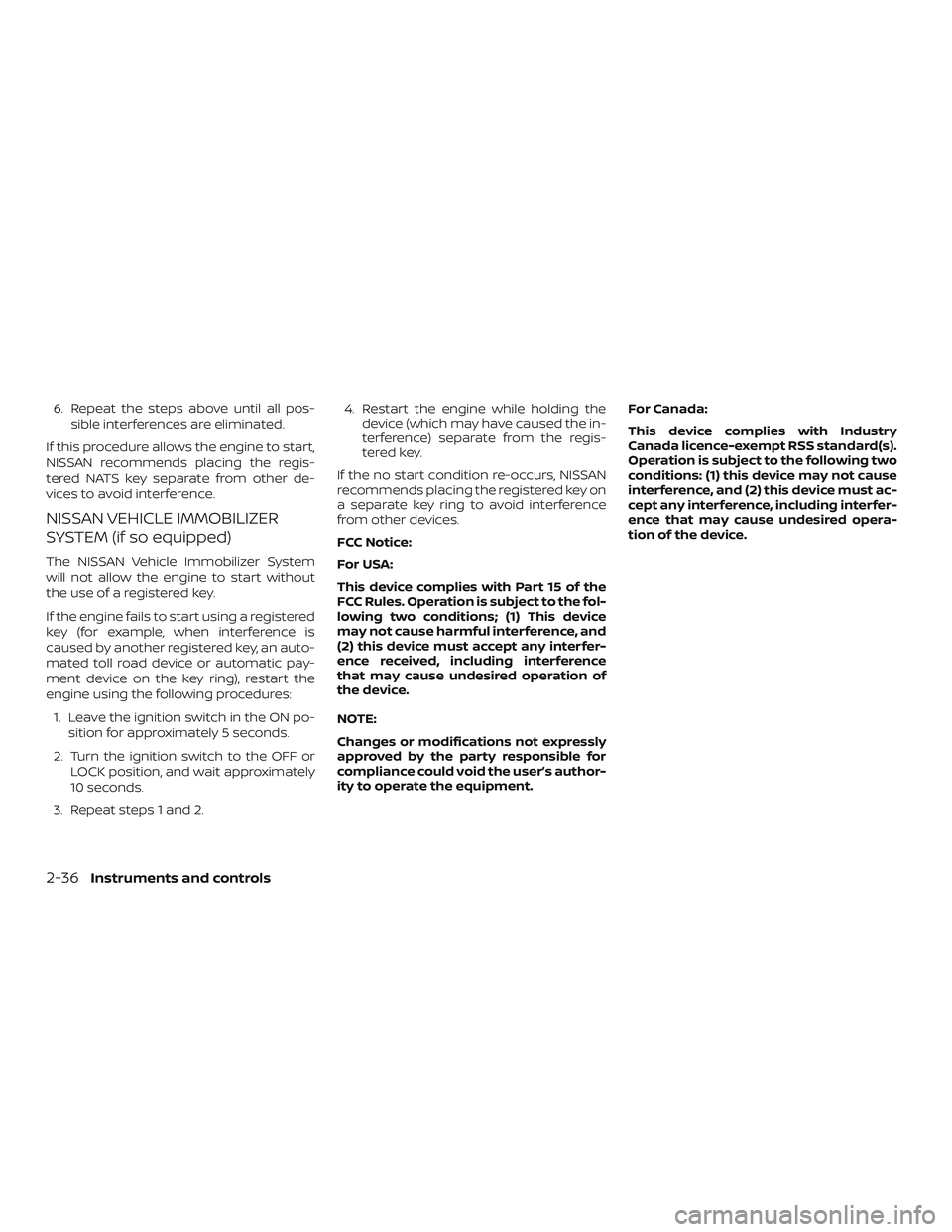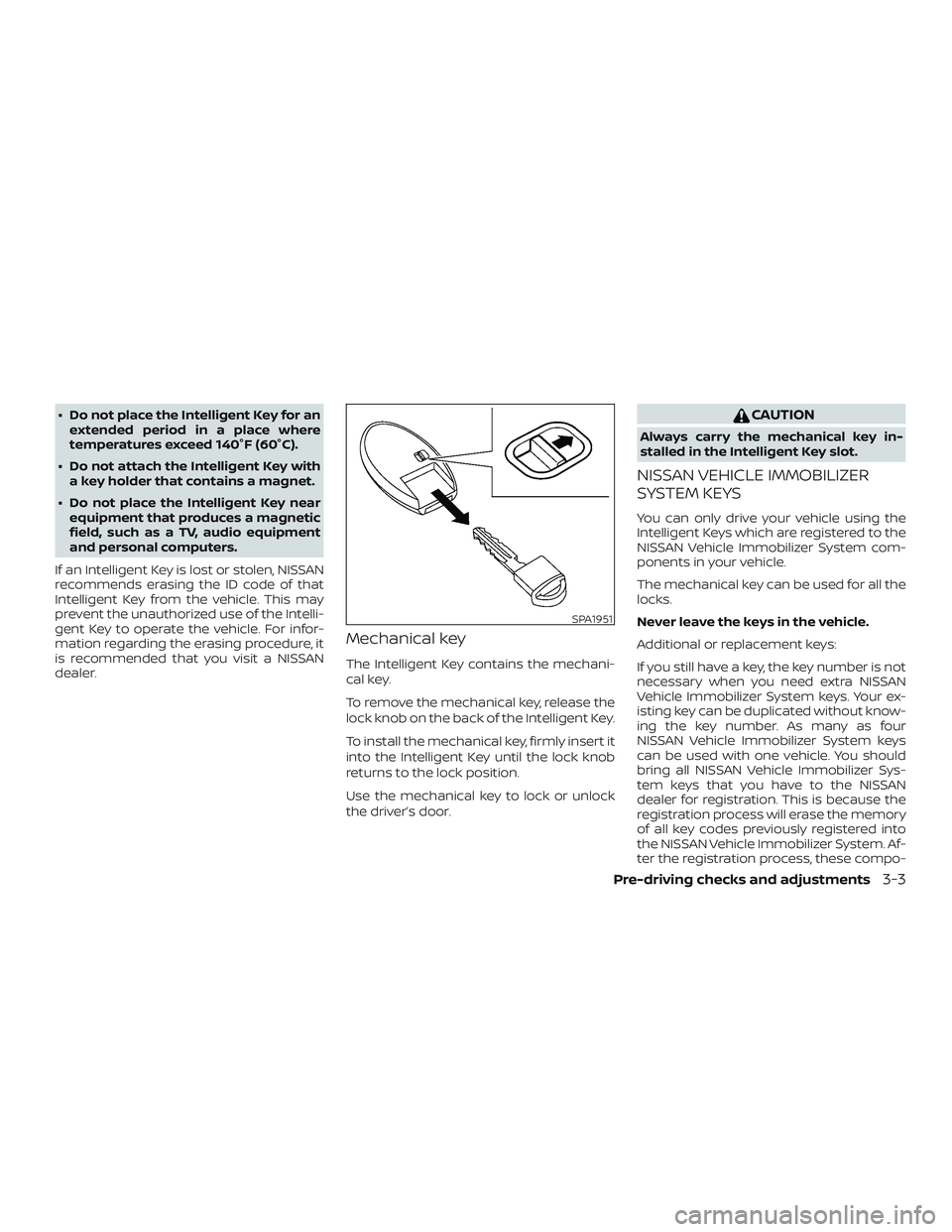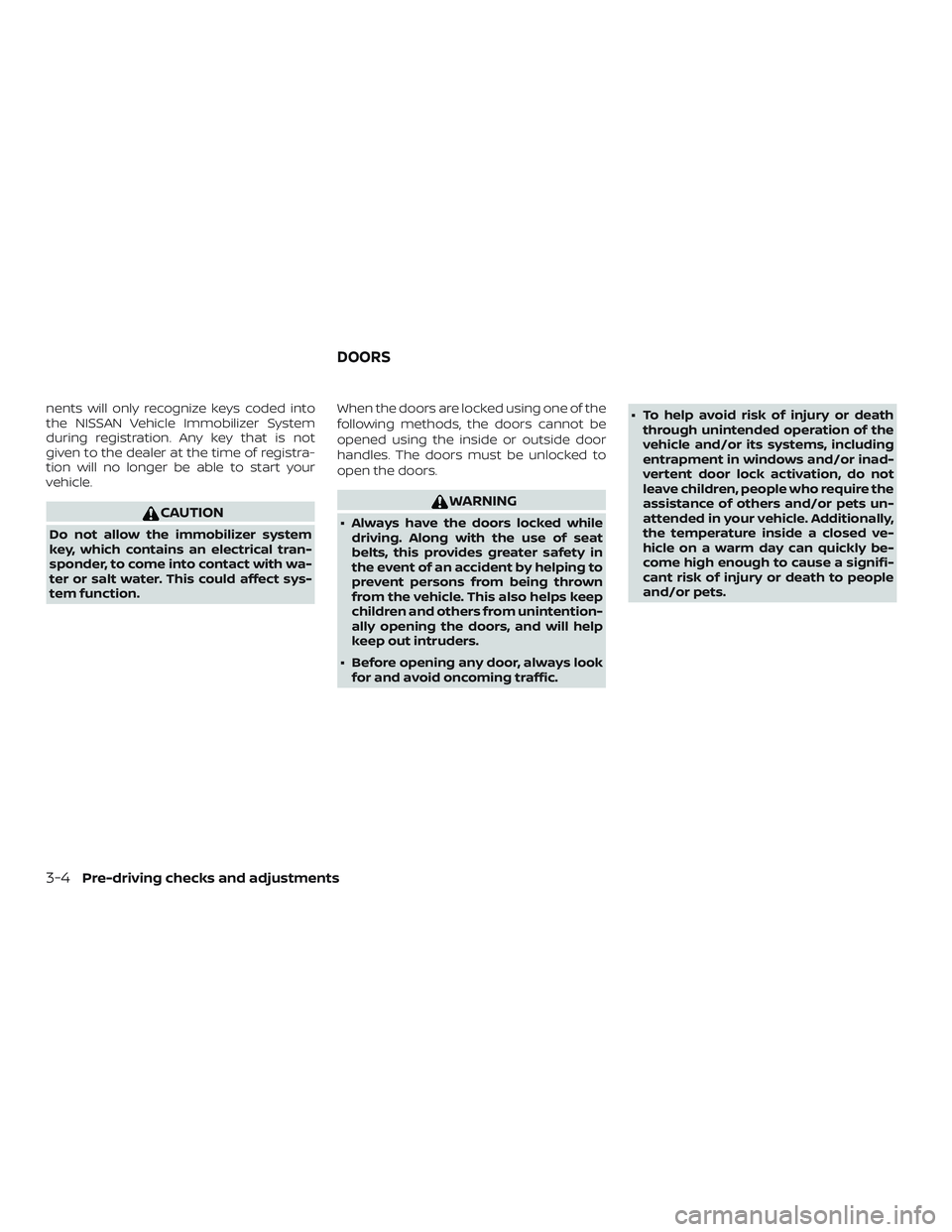2018 NISSAN LEAF immobilizer
[x] Cancel search: immobilizerPage 84 of 435

2 Instruments and controls
Instrument panel................................2-2
Meters and gauges ..............................2-4
Speedometer and odometer .................2-5
Tachometer .................................. 2-7
Fuel gauge ...................................2-8
Trip computer (if so equipped) ................2-9
Warning lights, indicator lights and audible
reminders ...................................... 2-10
Checking lights ............................... 2-11
Warning lights ................................ 2-11
Indicator lights .............................. 2-17
Audible reminders ........................... 2-20
Vehicle information display (if so equipped) .....2-21
How to use the vehicle information
display ...................................... 2-21
Startup display .............................. 2-22
Settings ..................................... 2-22
Vehicle information display warnings
and indicators ............................... 2-30
Security systems (if so equipped) ...............2-34
Vehicle security system .....................2-34
NISSAN Anti-Thef t System (NATS)
(if so equipped) .............................. 2-35NISSAN Vehicle Immobilizer System
(if so equipped)
.............................. 2-36
Wiper and washer switch .......................2-37
Switch operation ............................ 2-37
Rear switch operation .......................2-39
Rear window and/or outside mirror defroster
switch (if so equipped) .......................... 2-40
Headlight and turn signal switch ...............2-41
Headlight control switch .....................2-41
Daytime Running Lights (DRL) system
(if so equipped) .............................. 2-43
Instrument brightness control ...............2-44
Turn signal switch ........................... 2-44
Fog light switch (if so equipped) .............2-45
Horn ........................................... 2-45
Heated seat switches (if so equipped) ..........2-45
Automatic Emergency Braking (AEB) switch
(if so equipped) ................................. 2-46
Vehicle Dynamic Control (VDC) OFF switch ......
2-47
Power outlets ..................................2-47
12v outlets ...................................2-47
Extended storage switch .......................2-48
Storage ........................................ 2-49
Page 118 of 435

Front Radar Obstruction (if so
equipped)
This warning appears when there is a radar
obstruction detected. For additional infor-
mation, refer to “Automatic Emergency
Braking (AEB)” in the “Starting and driving”
section of this manual.
Side Radar Obstruction (if so equipped)
This message appears when the Blind
Spot Warning (BSW) or Rear Cross Traffic
Alert (RCTA) systems become unavailable
because a radar blockage is detected. For
additional information, refer to “Blind Spot
Warning (BSW)” or “Rear Cross Traffic Alert
(RCTA)” in the “Starting and driving” section
of this manual.
Sport mode indicator (if so equipped)
A small “S” appears to the right of the Trans-
mission Shif t Position indicator in the ve-
hicle information display when the Sport
mode is engaged.
Activate the Sport mode by pressing the
switch on the shif t lever while the shif t lever
is in the D (Drive) position.
For additional information, refer to “Driving
the vehicle” in the “Starting and driving” sec-
tion of this manual.Your vehicle may have three types of secu-
rity systems:
∙ Vehicle security system
∙ NISSAN Anti-Thef t System
∙ NISSAN Vehicle Immobilizer System
VEHICLE SECURITY SYSTEM
The vehicle security system provides visual
and audible alarm signals if someone
opens the doors or lif tgate when the sys-
tem is armed. It is not, however, a motion
detection type system that activates when
a vehicle is moved or when a vibration oc-
curs. The system helps deter vehicle thef t but
cannot prevent it, nor can it prevent the
thef t of interior or exterior vehicle compo-
nents in all situations. Always secure your
vehicle even if parking for a brief period.
Never leave your keys in the vehicle, and
always lock the vehicle when unattended.
Be aware of your surroundings, and park in
secure, well-lit areas whenever possible.
Many devices offering additional protec-
tion, such as component locks, identifica-
tion markers, and tracking systems, are
available at auto supply stores and spe-
cialty shops. A NISSAN dealer may also offer
such equipment. Check with your insur-
ance company to see if you may be eligible
for discounts for various thef t protection
features.
How to arm the vehicle security
system
1. Close all windows.
(The system can be
armed even if the windows are open.)
2. Remove the keys from the vehicle.
3. Close all doors and lif tgate. Lock all doors. The doors can be locked with
the key fob (if so equipped), Intelligent
Key (if so equipped), door handle re-
quest switch, or mechanical key.
LIC3633
SECURITY SYSTEMS (if so equipped)
2-34Instruments and controls
Page 120 of 435

6. Repeat the steps above until all pos-sible interferences are eliminated.
If this procedure allows the engine to start,
NISSAN recommends placing the regis-
tered NATS key separate from other de-
vices to avoid interference.
NISSAN VEHICLE IMMOBILIZER
SYSTEM (if so equipped)
The NISSAN Vehicle Immobilizer System
will not allow the engine to start without
the use of a registered key.
If the engine fails to start using a registered
key (for example, when interference is
caused by another registered key, an auto-
mated toll road device or automatic pay-
ment device on the key ring), restart the
engine using the following procedures: 1. Leave the ignition switch in the ON po- sition for approximately 5 seconds.
2. Turn the ignition switch to the OFF or LOCK position, and wait approximately
10 seconds.
3. Repeat steps 1 and 2. 4. Restart the engine while holding the
device (which may have caused the in-
terference) separate from the regis-
tered key.
If the no start condition re-occurs, NISSAN
recommends placing the registered key on
a separate key ring to avoid interference
from other devices.
FCC Notice:
For USA:
This device complies with Part 15 of the
FCC Rules. Operation is subject to the fol-
lowing two conditions; (1) This device
may not cause harmful interference, and
(2) this device must accept any interfer-
ence received, including interference
that may cause undesired operation of
the device.
NOTE:
Changes or modifications not expressly
approved by the party responsible for
compliance could void the user’s author-
ity to operate the equipment. For Canada:
This device complies with Industry
Canada licence-exempt RSS standard(s).
Operation is subject to the following two
conditions: (1) this device may not cause
interference, and (2) this device must ac-
cept any interference, including interfer-
ence that may cause undesired opera-
tion of the device.
2-36Instruments and controls
Page 149 of 435

3 Pre-driving checks and adjustments
Keys.............................................3-2NISSAN Intelligent Key® .......................3-2
NISSAN Vehicle Immobilizer System
keys..........................................3-3
Doors ...........................................3-4
Locking with key ..............................3-5
Locking with inside lock knob .................3-5
Locking with power door lock switch .........3-5
Automatic door locks.........................3-6
Child safety rear door lock ....................3-6
NISSAN Intelligent Key® ..........................3-6
Operating range ..............................3-8
Door locks/unlocks precaution ...............3-8
NISSAN Intelligent Key® operation .............3-9
How to use the remote keyless entry
function ..................................... 3-12
Warning signals ............................. 3-15
Troubleshooting guide ......................3-16
Remote Engine Start (if so equipped) ...........3-18
Remote Engine Start operating range .......3-18
Remote starting the vehicle .................3-19Extending engine run time
..................3-19
Canceling a Remote Engine Start ............3-19
Conditions the Remote Engine Start will
notwork .................................... 3-20
Hood ........................................... 3-21
Lif tgate ......................................... 3-21
Opening the lif tgate ......................... 3-23
Closing the lif tgate .......................... 3-23
Secondary lif tgate unlock ...................3-23
Fuel-filler door .................................. 3-24
Opener operation ........................... 3-24
Fuel-filler cap ................................ 3-25
Steering wheel ................................. 3-26
Manual operation ........................... 3-26
Sun visors ...................................... 3-26
Vanity mirrors ............................... 3-27
Card holder (driver’s side only) ...............3-27
Mirrors ......................................... 3-28
Manual anti-glare rearview mirror ...........3-28
Outside mirrors ............................. 3-28
Page 151 of 435

∙ Do not place the Intelligent Key for anextended period in a place where
temperatures exceed 140°F (60°C).
∙ Do not attach the Intelligent Key with a key holder that contains a magnet.
∙ Do not place the Intelligent Key near equipment that produces a magnetic
field, such as a TV, audio equipment
and personal computers.
If an Intelligent Key is lost or stolen, NISSAN
recommends erasing the ID code of that
Intelligent Key from the vehicle. This may
prevent the unauthorized use of the Intelli-
gent Key to operate the vehicle. For infor-
mation regarding the erasing procedure, it
is recommended that you visit a NISSAN
dealer.
Mechanical key
The Intelligent Key contains the mechani-
cal key.
To remove the mechanical key, release the
lock knob on the back of the Intelligent Key.
To install the mechanical key, firmly insert it
into the Intelligent Key until the lock knob
returns to the lock position.
Use the mechanical key to lock or unlock
the driver’s door.
CAUTION
Always carry the mechanical key in-
stalled in the Intelligent Key slot.
NISSAN VEHICLE IMMOBILIZER
SYSTEM KEYS
You can only drive your vehicle using the
Intelligent Keys which are registered to the
NISSAN Vehicle Immobilizer System com-
ponents in your vehicle.
The mechanical key can be used for all the
locks.
Never leave the keys in the vehicle.
Additional or replacement keys:
If you still have a key, the key number is not
necessary when you need extra NISSAN
Vehicle Immobilizer System keys. Your ex-
isting key can be duplicated without know-
ing the key number. As many as four
NISSAN Vehicle Immobilizer System keys
can be used with one vehicle. You should
bring all NISSAN Vehicle Immobilizer Sys-
tem keys that you have to the NISSAN
dealer for registration. This is because the
registration process will erase the memory
of all key codes previously registered into
the NISSAN Vehicle Immobilizer System. Af-
ter the registration process, these compo-
SPA1951
Pre-driving checks and adjustments3-3
Page 152 of 435

nents will only recognize keys coded into
the NISSAN Vehicle Immobilizer System
during registration. Any key that is not
given to the dealer at the time of registra-
tion will no longer be able to start your
vehicle.
CAUTION
Do not allow the immobilizer system
key, which contains an electrical tran-
sponder, to come into contact with wa-
ter or salt water. This could affect sys-
tem function.When the doors are locked using one of the
following methods, the doors cannot be
opened using the inside or outside door
handles. The doors must be unlocked to
open the doors.
WARNING
∙ Always have the doors locked while
driving. Along with the use of seat
belts, this provides greater safety in
the event of an accident by helping to
prevent persons from being thrown
from the vehicle. This also helps keep
children and others from unintention-
ally opening the doors, and will help
keep out intruders.
∙ Before opening any door, always look for and avoid oncoming traffic. ∙ To help avoid risk of injury or death
through unintended operation of the
vehicle and/or its systems, including
entrapment in windows and/or inad-
vertent door lock activation, do not
leave children, people who require the
assistance of others and/or pets un-
attended in your vehicle. Additionally,
the temperature inside a closed ve-
hicle on a warm day can quickly be-
come high enough to cause a signifi-
cant risk of injury or death to people
and/or pets.
DOORS
3-4Pre-driving checks and adjustments
Page 266 of 435

5 Starting and driving
Precautions when starting and driving..........5-2
Exhaust gas (carbon monoxide) ..............5-2
Three-way catalyst ...........................5-3
Tire Pressure Monitoring System
(TPMS)........................................5-3
On-pavement and off-road driving
precautions ..................................5-7
Avoiding collision and rollover ................5-7
Off-roadrecovery ............................5-7
Rapid air pressure loss .......................5-8
Drinking alcohol/drugs and driving ...........5-9
Push-button ignition switch .....................5-9
Operating range ............................. 5-10
Push-button ignition switch positions .......5-10
Emergency engine shut off ...................5-11
NISSAN Intelligent Key® battery
discharge ................................... 5-12
NISSAN Anti-Thef t System (NATS)
(if so equipped) .............................. 5-12
NISSAN Vehicle Immobilizer System
(if so equipped) .............................. 5-13
Before starting the engine ......................5-13
Starting the engine ............................. 5-14
Remote Engine Start (if so equipped) ........5-15 Driving the vehicle
.............................. 5-15
Continuously Variable Transmission
(CVT) ........................................ 5-15
Parking brake .................................. 5-21
Blind Spot Warning (BSW) (if so equipped) .......5-22
BSW system operation ......................5-23
How to enable/disable the BSW system .....5-24
BSW system limitations ......................5-25
BSW driving situations .......................5-26
System temporarily unavailable .............5-29
System maintenance ........................ 5-30
Rear Cross Traffic Alert (RCTA) (if so equipped) . . 5-31 RCTA system operation ......................5-32
How to enable/disable the RCTA
system ...................................... 5-34
RCTA system limitations .....................5-35
System temporarily unavailable .............5-37
System maintenance ........................ 5-38
Cruise control .................................. 5-39
Precautions on cruise control ................5-39
Cruise
control operations .................... 5-40
Automatic Emergency Braking (AEB)
(if so equipped) ................................. 5-41
AEB system operation .......................5-43
Page 279 of 435

5. Start the engine.
6. Repeat the steps above until all pos-sible interferences are eliminated.
If this procedure allows the engine to start,
NISSAN recommends placing the regis-
tered NATS key separate from other de-
vices to avoid interference.
NISSAN VEHICLE IMMOBILIZER
SYSTEM (if so equipped)
The NISSAN Vehicle Immobilizer System
will not allow the engine to start without
the use of the registered key.
If the engine fails to start using a registered
key (for example, when interference is
caused by another registered key, an auto-
mated toll road device or automatic pay-
ment device on the key ring), restart the
engine using the following procedures: 1. Leave the ignition switch in the ON po- sition for approximately 5 seconds.
2. Place the ignition switch in the OFF or LOCK position, and wait approximately
10 seconds.
3. Repeat steps 1 and 2. 4. Restart the engine while holding the
device (which may have caused the in-
terference) separate from the regis-
tered key.
If the no start condition re-occurs, NISSAN
recommends placing the registered key on
a separate key ring to avoid interference
from other devices. ∙ Make sure the area around the vehicle is
clear.
∙ Check fluid levels such as engine oil, coolant, brake fluid, and windshield-
washer fluid as frequently as possible,
or at least whenever you refuel.
∙ Check that all windows and lights are clean.
∙ Visually inspect tires for their appear- ance and condition. Also check tires for
proper inflation.
∙ Lock all doors.
∙ Position seat and adjust headrests/head restraints.
∙ Adjust inside and outside mirrors.
∙ Fasten seat belts and ask all passen- gers to do likewise.
∙ Check the operation of warning lights when the ignition switch is pushed to
the ON position. For additional informa-
tion, refer to “Warning lights, indicator
lights and audible reminders” in the “In-
struments and controls” section of this
manual.
BEFORE STARTING THE ENGINE
Starting and driving5-13